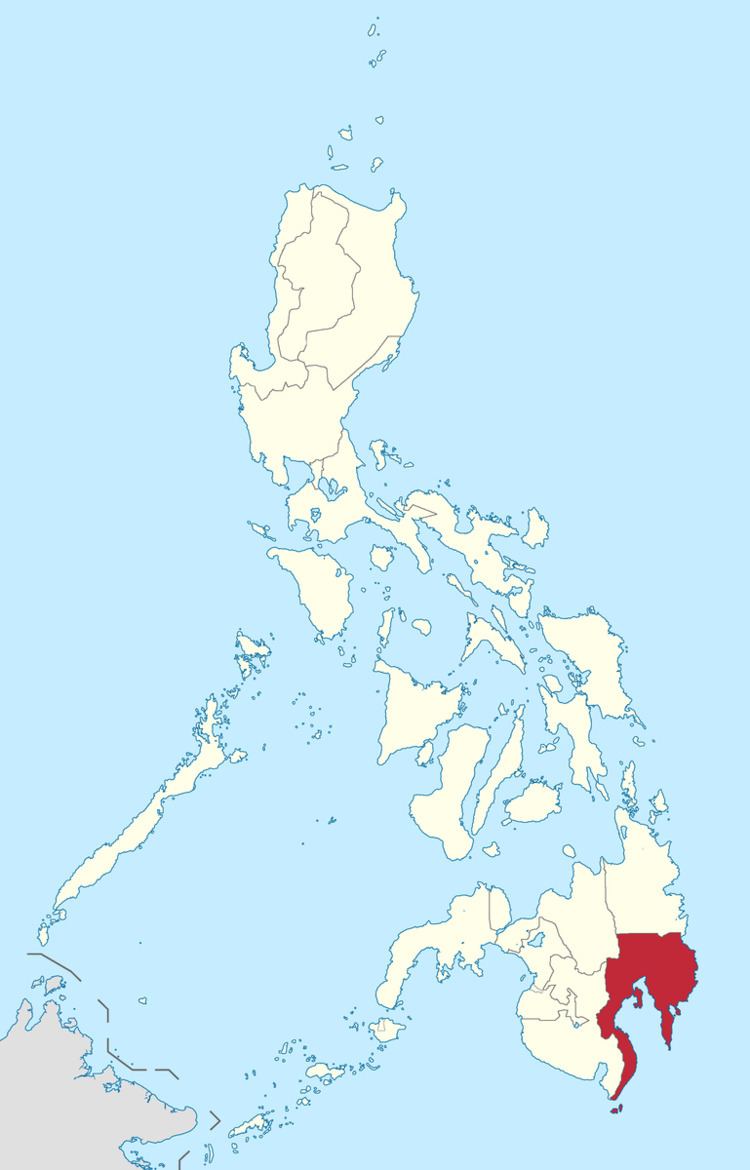1914-1967 → → → | ||
 | ||
Area 20,244 km (7,816 sq mi) Political subdivisions 36 municipalities & 1 city(before May 20, 1967)Davao CityBabakBagangaBanaybanayBansalanCateelCaragaCompostelaDigosDoña Alicia (later Mabini)HagonoyKapalongKaputianKiblawanLuponMagsaysayMalalagMalitaManayMatan-aoMatiMontevistaMoncayoNabunturanPadadaPanaboPantucanSamalSan IsidroSta. CruzSta. MariaSaug (later Asuncion)Sigaboy (later Gov. Generoso)SulopTagumTibal-og (later Sto. Tomas)Trinidad (later Jose Abad Santos) Today part of | ||
The Province of Davao (Spanish: Provincia de Dávao; Cebuano: Lalawigan sa Dabaw) was a province of the Philippines in the island of Mindanao. It was divided into three provinces of Davao del Norte, Davao Oriental, and Davao del Sur with the passage of Philippine Republic Act No. 4867 on May 20, 1967. It was one of the largest, most populous and prosperous provinces in the country during its time, being settled by immigrants from the Luzon and Visayas island groups.
Existence
The province was established after the dissolution of Moro Province in 1914. Before the province broke up, massive waves of immigrants from Visayas and Luzon island groups are already immigrating in the province. Japanese immigrants, mostly rich businessmen and pioneers, also immigrated to its capital Davao in large numbers, making it the Philippines' Little Japan. Having an area of more than 20,000 square kilometers, its borders were almost identical to its predecessor, the province of Nueva Guipúzcoa, which also covered parts of what are now Cotabato, South Cotabato, Sarangani, Bukidnon and the region of Caraga during the Spanish era.
It was made a district of Department of Mindanao and Sulu from 1914 until 1920.
Its capital town, Davao, became a city in March 16, 1936 as the provincial congressman Romualdo Quimpo filed Bill 609 (passed as Commonwealth Act 51), paving the creation of the city from the merger of the town of Davao (Mayo) and Guianga District. The bill called for the appointment of local officials by Commonwealth President Manuel L. Quezon. By then, it was the only city in the province throughout the latter's existence. What is now the Davao City Legislative Building served as the capitol for the governor and other provincial officials in the province.
On 1942, during the outbreak of World War II in the Philippines, forces of the Imperial Japanese Army invaded the province, becoming one of the territories in the country to be first taken by Japan. Guerrilla parties were then organized in the province to battle Japanese garrison forces there. It was in late 1944 when the Allies began liberating the island of Mindanao, and earlier the next year the dreadful Battle of Davao was fought to eliminate any Japanese resistance in the province.
The province was one of the few provinces in the country to recover quickly from the war. Its capital city resumed its role as the main economic center of Mindanao. Though some local Japanese inhabitants in the provinces were expelled from the country due to enmity after the war, most have been integrated to the local Filipino population. After the war, migration to the province has steadily increased due to the great employment and agricultural opportunities the province have, especially in its capital city.
In 1948, all municipal districts in the country have been abolished. This paved the way for the creation of several towns in the province, such as Digos, Padada, Compostela, and many others.
To reorganize governance in the country, President Ferdinand E. Marcos signed the Republic Act No. 4867 on May 8, 1967, dividing the province into three. The then-Davao Province is currently a region consisting of five provinces: Davao del Sur, Davao del Norte, Davao Occidental, Davao Oriental and Compostela Valley.
The province of Davao del Norte bore this name from 1972 until 1998, when Compostela Valley seceded as a separate province.
Davao Occidental was created by virtue of Republic Act 10360 enacted on July 23, 2013; the province is the newest in the country, carved out from the southern part of Davao del Sur. The Act was passed by the House of Representatives and the Senate on November 28, 2012, and December 5, 2012, respectively, and signed by President Benigno Aquino III on January 14, 2013. A plebiscite was held on October 28, 2013 along with the Barangay elections, and the majority of votes cast were "Yes", ratifying the province.
